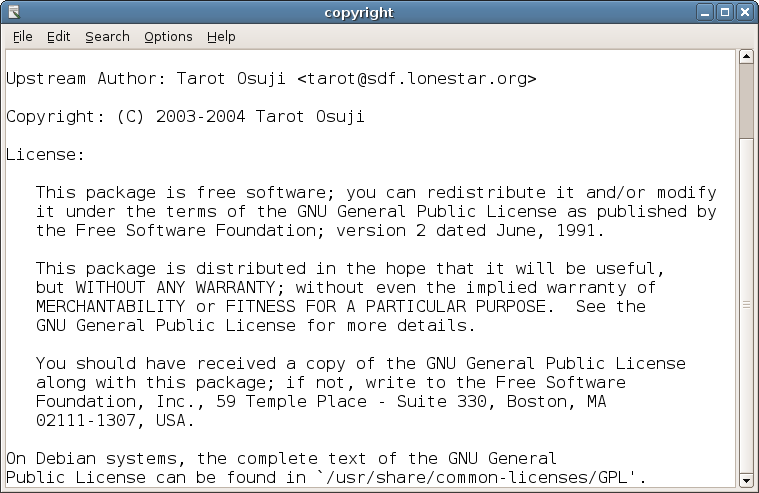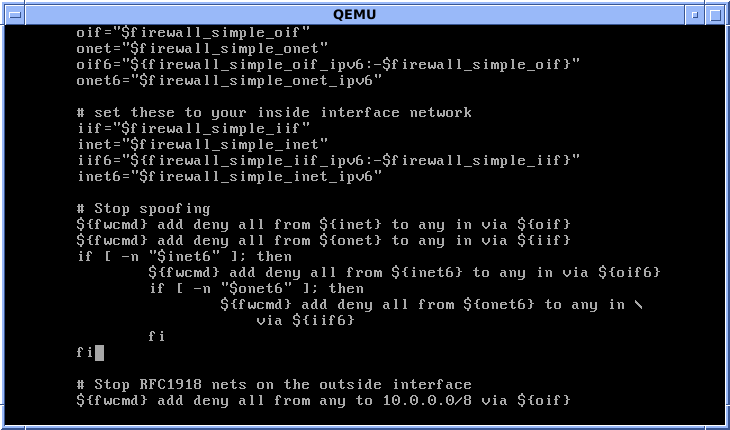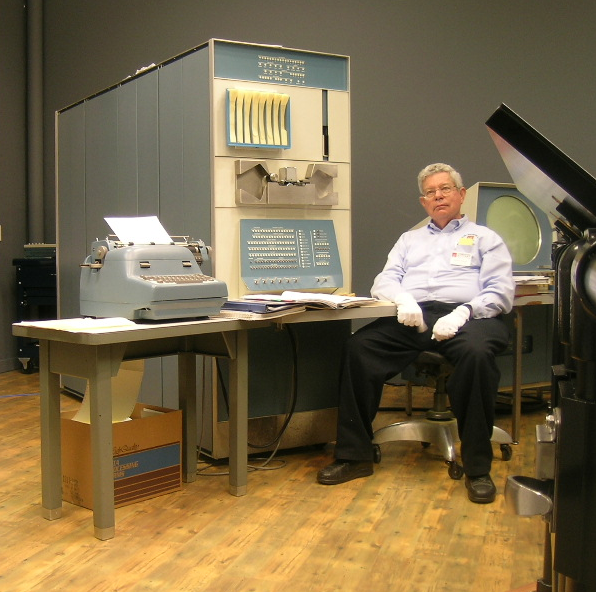|
Line Editor
In computing, a line editor is a text editor in which each editing command applies to one or more complete lines of text designated by the user. Line editors predate screen-based text editors and originated in an era when a computer operator typically interacted with a teleprinter (essentially a computer printer, printer with a Computer keyboard, keyboard), with no video display, and no ability to move a cursor interactively within a document. Line editors are limited to typewriter keyboard text-oriented input and output methods. Most edits are a line-at-a-time. Typing, editing, and document display do not occur simultaneously. Typically, typing does not enter text directly into the document. Instead, users modify the document text by entering these commands on a text-only terminal. Commands and text, and corresponding output from the editor, will scroll up from the bottom of the screen in the order that they are entered or printed to the screen. Although the commands typically ... [...More Info...] [...Related Items...] OR: [Wikipedia] [Google] [Baidu] |
Text Editor
A text editor is a type of computer program that edits plain text. An example of such program is "notepad" software (e.g. Windows Notepad). Text editors are provided with operating systems and software development packages, and can be used to change files such as configuration files, documentation files and programming language source code. Plain text and rich text There are important differences between plain text (created and edited by text editors) and rich text (such as that created by word processors or desktop publishing software). Plain text exclusively consists of character representation. Each character is represented by a fixed-length sequence of one, two, or four bytes, or as a variable-length sequence of one to four bytes, in accordance to specific character encoding conventions, such as ASCII, ISO/IEC 2022, ISO/IEC 2022, Shift JIS, UTF-8, or UTF-16. These conventions define many printable characters, but also whitespace character, non-printing characters th ... [...More Info...] [...Related Items...] OR: [Wikipedia] [Google] [Baidu] |
Ed (text Editor)
(pronounced as distinct letters, ) is a line editor for Unix and Unix-like operating systems. It was one of the first parts of the Unix operating system that was developed, in August 1969. It remains part of the POSIX and Open Group standards for Unix-based operating systems, alongside the more sophisticated full-screen editor vi. History and influence The ed text editor was one of the first three key elements of the Unix operating system— assembler, editor, and shell—developed by Ken Thompson in August 1969 on a PDP-7 at AT&T Bell Labs. Many features of ed came from the qed text editor developed at Thompson's alma mater University of California, Berkeley. Thompson was very familiar with qed, and had reimplemented it on the CTSS and Multics systems. Thompson's versions of qed were notable as the first to implement regular expressions. Regular expressions are also implemented in ed, though their implementation is considerably less general than that in qed. Den ... [...More Info...] [...Related Items...] OR: [Wikipedia] [Google] [Baidu] |
Diff
In computing, the utility diff is a data comparison tool that computes and displays the differences between the contents of files. Unlike edit distance notions used for other purposes, diff is line-oriented rather than character-oriented, but it is like Levenshtein distance in that it tries to determine the smallest set of deletions and insertions to create one file from the other. The utility displays the changes in one of several standard formats, such that both humans or computers can parse the changes, and use them for patching. Typically, ''diff'' is used to show the changes between two versions of the same file. Modern implementations also support binary files. The output is called a "diff", or a patch, since the output can be applied with the Unix program . The output of similar file comparison utilities is also called a "diff"; like the use of the word " grep" for describing the act of searching, the word ''diff'' became a generic term for calculating data difference ... [...More Info...] [...Related Items...] OR: [Wikipedia] [Google] [Baidu] |
Patch (Unix)
The computer tool patch is a Unix program that updates text files according to instructions contained in a separate file, called a ''patch file''. The patch file (also called a ''patch'' for short) is a text file that consists of a list of differences and is produced by running the related diff program with the original and updated file as arguments. Updating files with patch is often referred to as ''applying the patch'' or simply ''patching'' the files. History The original patch program was written by Larry Wall (who went on to create the Perl programming language) and posted to mod.sources (which later became comp.sources.unix) in May 1985. patch was added to XPG4, which later became POSIX. Wall's code remains the basis of "patch" programs provided in OpenBSD, FreeBSD, and schilytools. The Open Software Foundation, which merged into The Open Group, is said to have maintained a derived version. The GNU project/ FSF maintains its patch, forked from the Larry Wall version. Th ... [...More Info...] [...Related Items...] OR: [Wikipedia] [Google] [Baidu] |
Shell Script
A shell script is a computer program designed to be run by a Unix shell, a command-line interpreter. The various dialects of shell scripts are considered to be command languages. Typical operations performed by shell scripts include file manipulation, program execution, and printing text. A script which sets up the environment, runs the program, and does any necessary cleanup or logging, is called a wrapper. The term is also used more generally to mean the automated mode of running an operating system shell; each operating system uses a particular name for these functions including batch files (MSDos-Win95 stream, OS/2), command procedures (VMS), and shell scripts (Windows NT stream and third-party derivatives like 4NT—article is at cmd.exe), and mainframe operating systems are associated with a number of terms. Shells commonly present in Unix and Unix-like systems include the Korn shell, the Bourne shell, and GNU Bash. While a Unix operating system may have a different ... [...More Info...] [...Related Items...] OR: [Wikipedia] [Google] [Baidu] |
Edlin
Edlin is a line editor, and the only text editor provided with early versions of IBM PC DOS, MS-DOS and OS/2. Although superseded in MS-DOS 5.0 and later by the full-screen MS-DOS Editor, and by Notepad in Microsoft Windows, it continued to be included in the 32-bit versions of Microsoft operating systems up to Windows Server 2008 and Windows 10. History Edlin was created by Tim Paterson in two weeks in 1980, for Seattle Computer Products's 86-DOS (QDOS) based on the CP/M context editor ''ED'', itself distantly inspired by the DEC PDP-10 TOPS-10 EDIT text editor. Microsoft acquired 86-DOS and, after some further development, sold it as MS-DOS, so Edlin was included in v1.0–v5.0 of MS-DOS. From MS-DOS 6 onwards, the only editor included was the new full-screen MS-DOS Editor. Windows 95, 98 and ME ran on top of an embedded version of DOS, which reports itself as MS-DOS 7. As a successor to MS-DOS 6, this did not include Edlin. However, Edlin is included in the ... [...More Info...] [...Related Items...] OR: [Wikipedia] [Google] [Baidu] |
IBM PC
The IBM Personal Computer (model 5150, commonly known as the IBM PC) is the first microcomputer released in the List of IBM Personal Computer models, IBM PC model line and the basis for the IBM PC compatible ''de facto'' standard. Released on August 12, 1981, it was created by a team of engineers and designers at IBM, International Business Machines (IBM), directed by William C. Lowe and Philip Don Estridge in Boca Raton, Florida. Powered by an x86-architecture Intel 8088 processor, the machine was based on open architecture and third-party peripherals. Over time, expansion cards and software technology increased to support it. The PC had influence of the IBM PC on the personal computer market, a substantial influence on the personal computer market; the specifications of the IBM PC became one of the most popular computer design standards in the world. The only significant competition it faced from a non-compatible platform throughout the 1980s was from Apple Inc., Apple's Maci ... [...More Info...] [...Related Items...] OR: [Wikipedia] [Google] [Baidu] |
Ex (text Editor)
ex, (short for ''extended''), is a line editor for Unix systems originally written by Bill Joy in 1976, beginning with an earlier program written by Charles Haley. Multiple implementations of the program exist; they are standardized by POSIX. History The original Unix editor ed was distributed with the Bell Labs versions of the operating system in the 1970s. George Coulouris of Queen Mary College, London, which had installed Unix in 1973, developed an improved version called em in 1975 that could take advantage of video terminals. While visiting Berkeley, Coulouris presented his program to Bill Joy, who modified it to be less demanding on the processor; Joy's version became ex and got included in the Berkeley Software Distribution. ex was eventually given a full-screen visual interface (adding to its command line oriented operation), thereby becoming the vi text editor. In recent times, ex is implemented as a personality of the vi program; most variants of vi still have an ... [...More Info...] [...Related Items...] OR: [Wikipedia] [Google] [Baidu] |
Unisys
Unisys Corporation is a global technology solutions company founded in 1986 and headquartered in Blue Bell, Pennsylvania. The company provides cloud, AI, digital workplace, logistics, and enterprise computing services. History Founding Unisys’ history dates back to 1873 with E. Remington & Sons and the introduction of the first commercially viable typewriter to use the QWERTY keyboard layout. Over a hundred years later, the company became known as Unisys in 1986 through the merger of Mainframe computer, mainframe corporations Sperry Corporation, Sperry and Burroughs Corporation, Burroughs, with Burroughs buying Sperry for $4.8 billion. The new company's name was chosen from over 31,000 submissions in an internal competition when Christian Machen submitted the word "Unisys", which was composed of parts of the words "united", "information", and "systems". The merger was the largest in the computer industry at the time and made Unisys the second-largest computer company wit ... [...More Info...] [...Related Items...] OR: [Wikipedia] [Google] [Baidu] |
Teleprinter
A teleprinter (teletypewriter, teletype or TTY) is an electromechanical device that can be used to send and receive typed messages through various communications channels, in both point-to-point (telecommunications), point-to-point and point-to-multipoint communication, point-to-multipoint configurations. Initially, from 1887 at the earliest, teleprinters were used in telegraphy. Electrical telegraphy had been developed decades earlier in the late 1830s and 1840s, then using simpler Morse key equipment and telegraph operators. The introduction of teleprinters automated much of this work and eventually largely replaced skilled labour, skilled operators versed in Morse code with Data entry clerk, typists and machines communicating faster via Baudot code. With the development of early computers in the 1950s, teleprinters were adapted to allow typed data to be sent to a computer, and responses printed. Some teleprinter models could also be used to create punched tape for Compute ... [...More Info...] [...Related Items...] OR: [Wikipedia] [Google] [Baidu] |
PDP-1
The PDP-1 (Programmed Data Processor-1) is the first computer in Digital Equipment Corporation's PDP series and was first produced in 1959. It is known for being the most important computer in the creation of hacker culture at the Massachusetts Institute of Technology, Bolt, Beranek and Newman, and elsewhere. The PDP-1 is the original hardware for one of the first video games, Steve Russell's 1962 game '' Spacewar!.'' Description The PDP-1 uses an 18-bit word size and has 4096 words as standard main memory (equivalent in bit size to 9,216 eight-bit bytes, but in character size to 12,388 bytes since the system actually divides an 18-bit word into three six-bit characters), upgradable to 65,536 words. The magnetic-core memory's cycle time is 5.35 microseconds (corresponding roughly to a clock speed of 187 kilohertz); consequently most arithmetic instructions take 10.7 microseconds (93,458 operations per second) because they use two memory cycles: the first to fetch the instruc ... [...More Info...] [...Related Items...] OR: [Wikipedia] [Google] [Baidu] |
Digital Equipment Corporation
Digital Equipment Corporation (DEC ), using the trademark Digital, was a major American company in the computer industry from the 1960s to the 1990s. The company was co-founded by Ken Olsen and Harlan Anderson in 1957. Olsen was president until he was forced to resign in 1992, after the company had gone into precipitous decline. The company produced many different product lines over its history. It is best known for the work in the minicomputer market starting in the early 1960s. The company produced a series of machines known as the Programmed Data Processor, PDP line, with the PDP-8 and PDP-11 being among the most successful minis in history. Their success was only surpassed by another DEC product, the late-1970s VAX "supermini" systems that were designed to replace the PDP-11. Although a number of competitors had successfully competed with Digital through the 1970s, the VAX cemented the company's place as a leading vendor in the computer space. As microcomputers improved in t ... [...More Info...] [...Related Items...] OR: [Wikipedia] [Google] [Baidu] |






